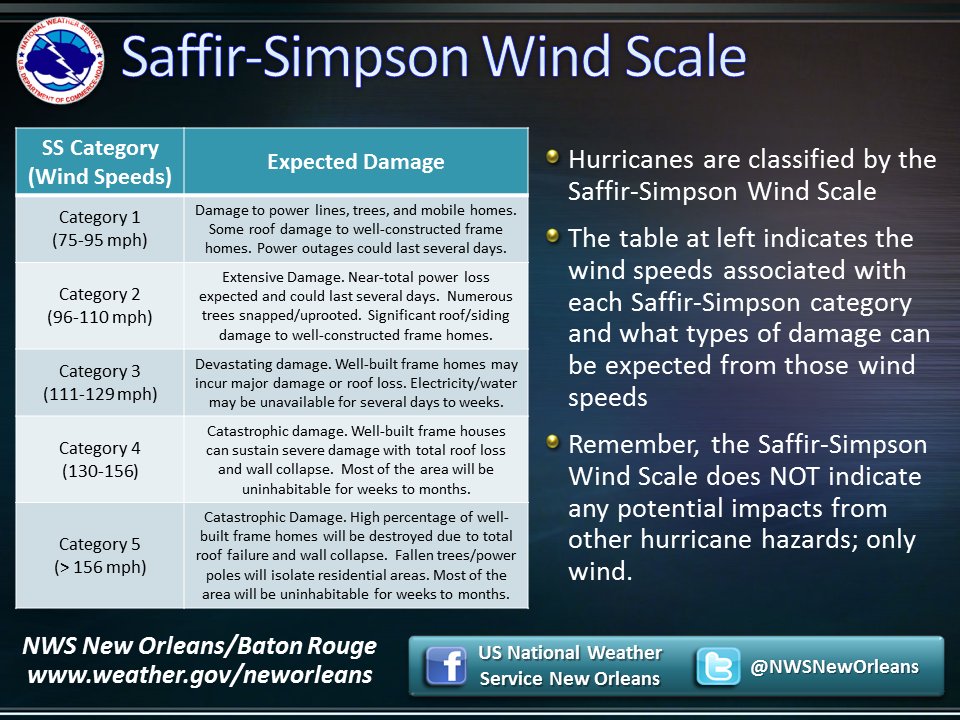Conceptual animation illustrates the wind damage associated with increasing hurricane intensity - courtesy of The COMET Program and the NOAA National Hurricane Center.
In the event of a hurricane or major weather event, it’s important to know the potential for property damage or loss of life.
The National Hurricane Center estimates potential damage by using the Saffir-Simpson Hurricane Wind Scale.
According to the National Hurricane Center, hurricanes reaching category 3 and higher are considered major hurricanes because of their potential for significant loss of life and damage.
Category 1 and 2 storms are still dangerous and require preventive measures.
Here is the breakdown of the categories based on wind speeds.
The Saffir-Simpson category describes only the WIND threat of a hurricane.
Category 1 storms are considered to have very dangerous winds and will produce some damage. Potential for damage includes:
- Well-constructed frame homes could have damage to roofs, shingles, vinyl siding and gutters.
- Large branches of trees will snap and shallowly rooted trees may be toppled.
- Extensive damage to power lines and poles likely will result in power outages that could last a few to several days.
Category 2 storms are considered to have extremely dangerous winds that will cause extensive damage.
Potential for damage includes:
- Well-constructed frame homes could sustain major roof and siding damage.
- Many shallowly rooted trees will be snapped or uprooted and block numerous roads.
- Near-total power loss is expected, with outages that could last from several days to weeks.
Category 3 (major): Sustained winds of 111-129 mph
Category 3 storms have winds that will cause devastating damage.
Potential for damage includes:
- Well-built frame homes may incur major damage or removal of roof decking and gable ends.
- Many trees will be snapped or uprooted, blocking numerous roads.
- Electricity and water will be unavailable for several days to weeks after the storm passes.
This animation of NOAA's GOES-East satellite imagery from Oct. 4 to Oct. 6 shows Hurricane Matthew making landfall on Oct. 4 in western Haiti and moving through the Bahamas on Oct. 6. TRT: 00:38.
Credit: NASA/NOAA GOES Project
Category 4 (major): Sustained winds of 130 - 156 mph
Category 4 storms have winds that will cause catastrophic damage.
Potential for damage includes:
- Well-built frame homes can sustain severe damage with loss of most of the roof structure and/or some exterior walls.
- Most trees will be snapped or uprooted and power poles downed.
- Fallen trees and power poles will isolate residential areas.
- Power outages will last weeks to possibly months. Most of the area will be uninhabitable for weeks or months.
Category 5 storms have wind that will cause catastrophic damage. Potential for damage includes:
- A high percentage of framed homes will be destroyed, with total roof failure and wall collapse.
- Fallen trees and power poles will isolate residential areas.
- Power outages will last for weeks to possibly months. Most of the area will be uninhabitable for weeks or months.
- Washington Post : Hurricane Matthew lashes Florida; emergencies declared in three states / Hurricane Matthew remains a dangerous and destructive Category 3 storm as it nears the Florida coast
- CNN : Hurricane Matthew: Live updates / What it's like in Hurricane Matthew's path
- Time :What to Know About Hurricane Matthew


No comments:
Post a Comment